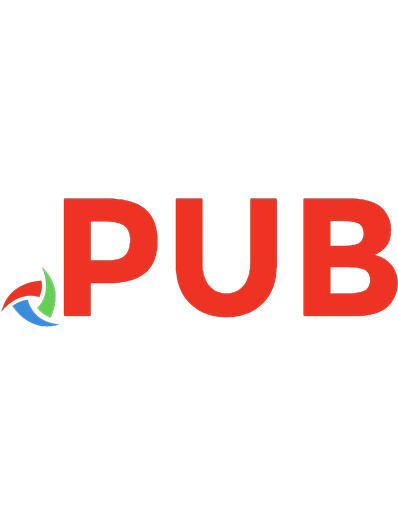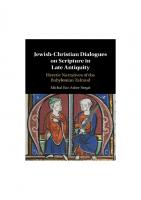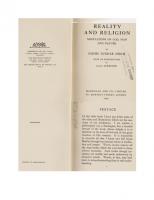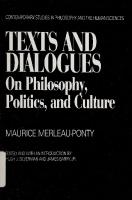Shattered Images: Dialogues and Meditations on Tsimshian Narratives 9780773595668
151 9 5MB
English Pages [329] Year 1987
Polecaj historie
Table of contents :
Cover
Title
The Carleton Library Series
Copyright
Acknowledgement
Dedication
Table of Contents
Preface
Chapter 1: Perceptions
Boas and Reconstruction through Myth
Phenomenology and Reconstruction through Narratives
An Ethnographic Overview of Tsimshian Oral Tradition
Notes
Chapter II: The Totemic Vision
On Mortality and Existence
Contingency and Luck
Humans as Real-Beings
Crests and Powers
Names and Real-Being
The Story Begins
Notes
Chapter III: Reflections in a Shaman's Mirror
The Shaman’s Mirror
The Meditation Experiments
Becoming a Shaman
The Shaman as Healer
The Story Continues
Notes
Chapter IV: Secret Societies and Refractions
The Origins of Secret Societies
Categories and Collectives
Secret Society Rituals
Dancers and Dog-Eaters
Cannibals and Destroyers
Residual Problems and Naxnox Dramatizations
The Story Ends
Notes
Chapter V: Projections and Images
The Tsimshian Concept
Dialogue Between Images of Humanness
The Denial of Death
Freedom and Fallibility
Appendix: Narrative Index
Bibliography
Index
List of Tables
1. Tsimshian Clans and Crests
2. Gitksan Crests and Referents
3. Houses by Cultural Division and Crest
4. An Inventory of Shamanic Regalia
5. The Mirror Hypotheses and Variables
6. Names for Slate Mirrors
7. Some Examples of Halait Names
List of Figures
Figure 1. Totemic and Secret Society Hierarchies
Citation preview
D I A L O G U E S AND ME DI TA TI ONS ON T SI MS HI AN N A R R A T I V E S
John C ove Carleton Universiiy Press Ottawa, Ca na d a
The cover illustration, by Katherine Allgeier, shows a shattered shaman’smirror with a face painted on it which represents a meditation experience. THE CARLETON LIBRARY SERIES
A series of original works, newcollections, and reprints of source material relating to Canada, issued under the supervision of the Editorial Board, Carleton Library Series, Carleton University Press Inc., Ottawa, Canada. __ General Editor
I-
Michael Gnarowski
1°}
Associate General Editor
72
Peter Emberley
Editorial Board Leslie Copley (Science) Bruce Cox (Anthropology ) John deVries (Sociology ) Peter Emberley (Political Science) J. Keith Johnson (H istory ) David B. Knight ( Geography) Michael McNeil (Law) T.K. Rymes (Economics) Canadian Cataloguing in Publication Data
Cove, John J. Shattered images : dialogues and meditations onTsimshian narratives (The Carleton library ; no. 139) ISBN 0-88629-053-8 1. Tsimshian Indians—Social life and customs. 2. Tsimshian Indians—Psychology. 3. Tsimshian Indians —Religion and mythology. 4. Indians of North America —Social life and customs. 5. Indians of North America—Psychology. 6. Indians of North America—Religion and mythology. I. Title. II. Series. E99.T8C68 1986
306'.08997
C87-0900I6-I
SHATTERED IMAGES: DIALOGUES AND MEDITATIONS ON TSIM SHIAN NARRATIVES
©Carleton University Press Inc., 1987 ISBN 0-88629-053-8 (paperback) Printed and bound in Canada. Distributed by: Oxford University Press Canada, 70 Wynford Drive, DON MILLS, Ontario, Canada, M3C 1J9. (416) 441-2941
Acknowledgements Carleton University Press gratefully acknowledges the support extended to its publishing programme by the Canada Council and the Ontario Arts Council.
Acknowledgments This book has been published with the help of a grant from the Social Science Federation of Canada, using funds provided by the Social Sciences and Humanities Research Council of Canada. In addition, a grant was received from the Faculty of Social Sciences, Carleton University, to assist in preparing the manuscript. Less tangibly, I have been assisted by a number of other organizations and individuals. Given my reliance on the Barbeau and Beynon data, I would like to especially acknowledge the C anadian Museum of Civilization for granting access to them and allowing me to quote extensively from those materials. In addition, I wish to thank Rene Landry, Scott Clark, Deborah Hyde, Derek Smith, M arie Wilson, Violet Smith, M argaret Seguin, Jam es M orrison, Gareth Douglas, Joanne M acDonald, Glenn Williams, Alfred Joseph, M ark Duiven, Peter Grant, Susan M arsden, and Don Ryan. They each made special contributions to this project, often in ways they would not recognize from the finished product. Finally, I wish to state my special debt to Ruth Goldsteen for her editorial work. Her efforts transform ed the original manuscript.
DEDICATION To my parents who have become my friends.
Note on Orthography The Tsimshian speak four distinct languages, and practically every field-worker has used a different orthography. Claiming no linguistic competence, and taking the cow ard’s way out, I decided to avoid contributing to the confusion as much as possible. In quoting from written sources, I generally used their o rthographies, only changing sym bols not found on conventional keyboards and eliminating most accent marks and superscripts. Otherwise, I employed one based loosely on the work of Powell, Dunn, and Rigsby. Since the majority of Tsimshian terms referred to come from either Gitksan or Tsimshian proper, where they differ significantly, I have tried to give both.
Table of Contents P reface ...................................................................................... 1 C ha pter 1 Perceptions .................................................................................. 7 Boas and Reconstruction through Myth ........................ 13 Phenomenology and Reconstruction through Narratives .......................................................... 18 An Ethnographic Overview of Tsimshian Oral Tradition .............................................. 42 Notes ...................................................................................... 48 C hapter II The Totemic Vision ................................................................. On M ortality and Existence .............................................. Contingency and Luck ....................................................... Humans as Real-Beings ................................................... Crests and Powers ......................................................... Names and Real-Being ................................................. The Story Begins ............................................................... Notes ....................................................................................
49 51 93 Ill 112 125 153 156
C hapter III Reflections in a Shaman's M irror ...................................... The Sham an’s M irror ....................................................... The M editation Experiments ...................................... Becoming a Shaman ......................................................... The Shaman as Healer ..................................................... The Story Continues ......................................................... Notes ....................................................................................
157 167 173 177 196 227 228
C hapter IV Secret Societies and Refractions ........................................ .229 The Origins of Secret Societies ........................................233 Categories and Collectives ................................................239
Secret Society Rituals ....................................................... Dancers and Dog-Eaters .............................................. Cannibals and Destroyers ........................................... Residual Problems and Naxnox Dram atizations .............................................................. The Story Ends .................................................................. Notes ....................................................................................
249 250 264 275 280 281
C hapter V Projections and Images ........................................................ The Tsimshian Concept ................................................... Dialogue Between Images of Humanness .................... The Denial of Death ..................................................... Freedom and Fallibility ...............................................
283 286 292 292 295
A ppendix Narrative Index ......................................................................
301
Bibliography ...........................................................................
308
Index ........................................................................................ 317
List of Tables 1. 2. 3. 4. 5. 6. 7.
Tsimshian Clans and Crests ............................................. Gitksan Crests and Referents ........................................ Houses by Cultural Division and Crest ....................... An Inventory of Shamanic Regalia .............................. The M irror Hypotheses and Variables ........................ Names for Slate M irrors ................................................. Some Examples of Halait Names .................................
List of Figures Figure 1. Totemic and Secret Society Hierarchies
79 113 123 166 169 171 240
245
Preface This book presents a lie. It deals with how one Northwest Coast culture, the Tsimshian, may have understood what it meant to be human. Although the results are as honest as I can make them, how they were reached bears virtually no relationship to the process of inquiry to be described. The research was motivated by reasons which are not a necessary part of the analysis. Similarly, the question and approach taken were not worked out prior to the investigation; rather, they were by products of it. W hat actually occurred was more like a series of accidents, with few if any connections among them worthy of the label logical. In a sense, the lie is unavoidable. Com munication, even within science, does not require honesty. That quality would more likely inhibit the process if the objective is to present a set of conclusions. Anyone who has done exploratory research has almost certainly faced the same dilemma. W hat is amazing is how seldom it is recognized. Once caught up in the attem pt to communicate, the activity takes on its own reality, and the author winds up believing that the form of argument is actually what happened. It is only when one pauses and reflects that the fiction becomes apparent. This preface is derived from such a moment of self reflection. It refers to only one aspect of the project: how the question was formulated. If there are any merits in discussing it, they have to do with destroying the implicit impression of an underlying academic m otivation, and with providing another opportunity to acknowledge, in a more descriptive way, some of the people who ultimately shaped what occurred. The study has its roots in an entirely different topic of investigation. In 1973, I was planning to do a com puter simulation of traditional Northwest Coast salmon fishing in order to test some of the ecological theories about potlatch. While rereading the literature, I noticed a reference to famine themes in Tsimshian mythology. I decided to do a cursory examination of them to see if they might provide some insights 1
into fish scarcities. The mythology, however, seemed to have other ideas. It captured me. The simulation, along with a specialization in economic anthropology, were completely discarded. Some m onths later, Charles Ackerman arranged an in formal workshop on structuralism at Carleton University. The Tsimshian were chosen as an ethnographic focus. It was my first opportunity to actually apply structuralism. I became fascinated by the potentials of the method and the mythology, but could not establish a sense of direction. I was unable to find a central question to address, and became discouraged with a seemingly endless number of interesting analyses which lacked a sense of unity outside of structuralist assumptions about the mind. Out of frustration, the mythology was put aside for over a year in order to more fully explore the ethnographic record. Thanks to the workshop I had met George M acDonald and through him gained access to the resources of the National M useum of M an, now known as the Canadian Museum of Civilization. This included the Barbeau-Beynon Tsimshian Files and material culture holdings. The richness of these data put myth into a broader perspective. Discussions with George M acDonald, Marie-Fran




![Dialogues on Gun Control (Philosophical Dialogues on Contemporary Problems) [1 ed.]
0367615320, 9780367615321](https://dokumen.pub/img/200x200/dialogues-on-gun-control-philosophical-dialogues-on-contemporary-problems-1nbsped-0367615320-9780367615321.jpg)





